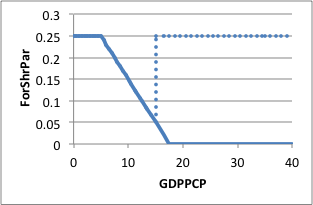International Futures Help System
Changes in Cropland due to Investment and/or Depreciation
The changes in cropland are driven by the economics of land. Specifically, they are a function of the profitability of cropland. Also, they are assumed to affect, at least directly, only the forest and the other land categories.
A maximum amount of cropland expansion each year (MaxLandExpansion) is fixed by the amount of forest land, the amount of other lands, the amount of potential arable land, and the existing amount of cropland. The maximum amount of expansion must be at least 2/100th of the existing cropland, but beyond that it cannot exceed either the total amount of forest and other land or the difference between 110% of the potential arable land (landarablepot) and current cropland.
The change in the amount of cropland and the initially estimated share of agricultural investment going to cropland in the following year are computed differently depending upon the maximum amount of cropland expansion relative to the amount of existing cropland and the current level of average income in a country. Specifically, if the maximum amount of cropland expansion is less than 10 percent of existing cropland or if the average income in the country is greater than $10,000 (GDPPCP > 10), then it is assumed that there is no change in cropland (lddev = 0) and that no agricultural investment is targeted for cropland development (IALK = 0).
If neither of the conditions mentioned in the previous paragraph is met, i.e., if the country is not too wealthy and there is an ‘adequate’ amount of land for expanding cropland, the amount of change in cropland (lddev) is initially calculated as
![]()
where
iaval is the total amount of funds available for investment in agriculture
IALK is the share of agricultural investment going to cropland development
CLD is the unit cost of cropland development
dkl is the depreciation rate of investment in cropland (essential a maintenance cost for existing cropland)
ldcropm
is a country-specific multiplier that can be used to increase or decrease changes in cropland
Note that this equation takes into account the need to maintain existing cropland. Also, at this point, the value of lddev is bound from below to ensure that it does not imply a greater than 10 percent decrease in existing cropland. For relatively poor countries (GDPPCP < 10), the constraint is even stricter. Specifically, IFs calls for a shift in funds to ensure that no cropland is lost. The desired shift in funds is given as
![]()
The actual shift in funds is limited to 90 percent of the available funds, however, where the available funds are the investment in agriculture not initially designated for cropland development

The value of lddev given the actual shift in funds is given as
![]()
In addition, the share of investment in agriculture designated for cropland development is updated to be [1]
The changes in cropland are linked to changes in land in the forest and ‘other’ categories. The amount coming from/going to forests reflects the share of forest land relative to ‘other’ land, as well as the current level of development
![]()
where
ForShrPar is given by the function depicted below that

The solid line holds when land is being converted from forests to cropland (lddev > 0) and the dotted line holds when land is being converted from cropland to forests (lddev < 0). In either case, this implies that the less of the change is related to forest land than would be expected by its share. Two other qualifiers are that the changes in forest land (LDDEVFor) and the changes in ‘other’ land cannot exceed 90 percent of existing land in these categories and the shifts cannot result in either land category falling below 1,000 hectares. These limits feedback to the change in cropland, finally resulting in the following
![]()
![]()
![]()
![]()
Turning back to the future cost of cropland development, this is estimated differently based only on whether there is ‘adequate’ room for cropland land expansion, defined as when the maximum amount of cropland expansion is greater than 10 percent of existing cropland. If this is the case, the future price of cropland is estimated as
![]()
where
RemRat is the ratio of the maximum land for expansion in the first year to the maximum land for expansion in the current year, with a maximum value of 10

This basically states that the price of cropland development grows linearly with growth in cropland and exponentially with declines in available land for cropland expansion.
Alternatively, if the maximum amount of cropland expansion in a given year is less than or equal to10 percent of existing cropland, the cost of bringing new land under cultivation is assumed to grow at the maximum of either 2 percent per year from the cost in the first year or the growth of cropland from the first year. Furthermore, it is not allowed to decline. Thus,
![]()
 International Futures at the Pardee Center
International Futures at the Pardee Center